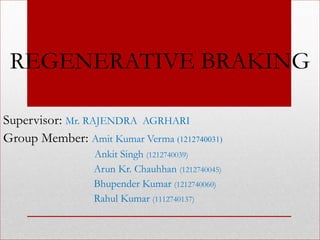
Power generating using Regenerative Braking system ppt
- 1. REGENERATIVE BRAKING Supervisor: Mr. RAJENDRA AGRHARI Group Member: Amit Kumar Verma (1212740031) Ankit Singh (1212740039) Arun Kr. Chauhhan (1212740045) Bhupender Kumar (1212740060) Rahul Kumar (1112740137)
- 2. INTRODUCTION • For three decades now, the second commandment of every automotive engineer – right behind ‘reduce cost’ – has been ‘reduce fuel consumption.’ The drive to use less fossil fuel has dictated the design of engines, transmissions and control systems for decades. Now, it is pushing the development of completely different technologies for generating power. • In spite of all these truly marvelous improvements, the energy efficiency of the most modern production car is still less than 20 percent. Most of the energy used to move the vehicle at any speed over any distance is literally thrown away as heat. About half of that wasted energy goes through the brakes. Today, almost every manufacturer is developing ways to recover a significant portion of that wasted energy with regenerative braking. 2
- 3. WHAT IS REGENERATIVE BRAKING? • A regenerative brake is an apparatus, a device or system which allows a vehicle to recapture part of the kinetic energy that would otherwise be 'lost' to heat when braking and make use of that power either by storing it for future use or feeding it back into a power system for other vehicles to use. • Regenerative braking is used on hybrid gas/electric automobiles to recoup some of the energy lost during stopping. This energy is saved in a storage battery and used later to power the motor whenever the car is in electric mode. 3
- 4. HOW IT WORKS • Regenerative braking does more than simply stop the car. Electric motors and electric generators (such as a car's alternator) are essentially two sides of the same technology. Both use magnetic fields and coiled wires, but in different configurations. Regenerative braking systems take advantage of this duality. Whenever the electric motor of a hybrid car begins to reverse direction, it becomes an electric generator or dynamo. This generated electricity is fed into a chemical storage battery and used later to power the car at city speeds. 4
- 5. REQUIREMENTS 1.1. WOOD STRUCTUREWOOD STRUCTURE 2.2. WHEELWHEEL 3.3. SMALL WHEELSMALL WHEEL 4.4. PULLEYPULLEY 5.5. MOTORMOTOR 6.6. DC GENERATORDC GENERATOR 7.7. BATTERYBATTERY 8.8. INVERTER(6W)INVERTER(6W) 9.9. TUBE LIGHT(6W)TUBE LIGHT(6W) 10.10. SOLAR PLANELSOLAR PLANEL 5
- 8. 8 Bridge transformer capacitor Motor & wheel Apply brake Stepper motor batteryinverter Solar panel bulb
- 9. • Regenerative braking takes energy normally wasted during braking and turns it into usable energy. It is not, however, a perpetual motion machine. Energy is still lost through friction with the road surface and other drains on the system. The energy collected during braking does not restore all the energy lost during driving. It does improve energy efficiency and assist the main alternator. • Regenerative braking is a benefit of hybrid electric vehicles, whereby some of the translational energy of the vehicle is captured and returned to an energy storage device when the brake pedal is applied. This is different from conventional braking, in which a car is slowed through friction and the energy of the car is lost through waste heat. • The energy recaptured by regenerative braking might be stored in one of three devices: an electrochemical battery, a flywheel, or in a regenerative fuel cell. 9
- 10. REGENERATIVE BRAKING AND BATTERIES • The electric motor of a car becomes a generator when the brake pedal is applied. The kinetic energy of the car is used to generate electricity that is then used to recharge the batteries. With this system, traditional friction brakes must also be used to ensure that the car slows down as much as necessary. Thus, not all of the kinetic energy of the car can be harnessed for the batteries because some of it is "lost" to waste heat. Some energy is also lost to resistance as the energy travels from the wheel and axle, through the drivetrain and electric motor, and into the battery. 10
- 11. 11
- 12. REGENERATIVE BRAKING ADVANTAGES • Provide greater fuel economy • Greater improvement in emission reduction • Energy savvy (energy conversion will be carefully controlled in the interest of maximum efficiency) • Provide ample drive power and power for sudden acceleration. • Enhance the efficiency of the engine and the overall economy of the car. 12
- 13. REGENERATIVE BRAKING DISADVANTAGES The main disadvantage of regenerative brakes when compared with dynamic brakes is the need to closely match the electricity generated with the supply. With DC supplies this requires the voltage to be closely controlled and it is only with the development of power electronics that it has been possible with AC supplies where the supply frequency must also be matched (this mainly applies to locomotives where an AC supply is rectified for DC motors). 13